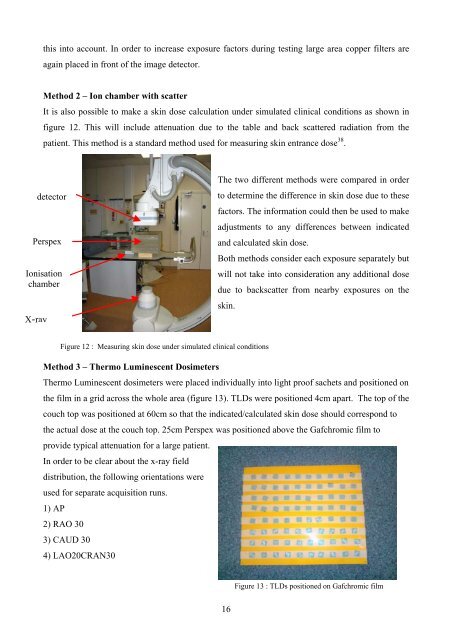Sandra Hopkins Final Report.pdf - University of Surrey
Sandra Hopkins Final Report.pdf - University of Surrey
Sandra Hopkins Final Report.pdf - University of Surrey
You also want an ePaper? Increase the reach of your titles
YUMPU automatically turns print PDFs into web optimized ePapers that Google loves.
this into account. In order to increase exposure factors during testing large area copper filters areagain placed in front <strong>of</strong> the image detector.Method 2 – Ion chamber with scatterIt is also possible to make a skin dose calculation under simulated clinical conditions as shown infigure 12. This will include attenuation due to the table and back scattered radiation from thepatient. This method is a standard method used for measuring skin entrance dose 38 .X-raydetectorPerspexIonisationchamberThe two different methods were compared in orderto determine the difference in skin dose due to thesefactors. The information could then be used to makeadjustments to any differences between indicatedand calculated skin dose.Both methods consider each exposure separately butwill not take into consideration any additional dosedue to backscatter from nearby exposures on theskin.Figure 12 : Measuring skin dose under simulated clinical conditionsMethod 3 – Thermo Luminescent DosimetersThermo Luminescent dosimeters were placed individually into light pro<strong>of</strong> sachets and positioned onthe film in a grid across the whole area (figure 13). TLDs were positioned 4cm apart. The top <strong>of</strong> thecouch top was positioned at 60cm so that the indicated/calculated skin dose should correspond tothe actual dose at the couch top. 25cm Perspex was positioned above the Gafchromic film toprovide typical attenuation for a large patient.In order to be clear about the x-ray fielddistribution, the following orientations wereused for separate acquisition runs.1) AP2) RAO 303) CAUD 304) LAO20CRAN30Figure 13 : TLDs positioned on Gafchromic film16
















